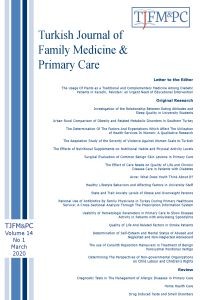The Usage Of Plants as a Traditional and Complementary Medicine Among Diabetic Patients in Karachi, Pakistan: an Urgent Need of Educational İntervention
Öz
A one-month cross-sectional and questionnaire-based study
was carried out in a government-based teaching hospital in Peshawar (Pakistan)
during January 2019. Adult population having diabetes and interact with CAM for
treatment purposes were approached. The simple random sampling technique was
used for the participant's enrollment. A participant has a full choice to
accept or reject to participate in the study. All the information collected via
a validated questionnaire and then data were entered into the Statistical
Package for Social Sciences (SPSS) for further analysis.
A total of 100 individuals was investigated during the
study period. The sample were mostly male (n= 62), came from rural
(n= 77), aged group 30-59 years (n= 83), and 56 patients had Illiterate status.
The ratio of type-2 patients (n=89) was higher
than as compared to type-1 DM patients (n=11). Out of these patients the prevalence of clinical characteristic included anxiety
(47.1%), chronic pain (33.9%), arthritis (30.6%), concomitant heart disease
(20.7%), digestive problems (22.3%), renal disease (15.7%) and allergies (4.1%).
More patients (n=68) considered conventional therapy more effective for diabetes,
while 7 reported CAM and 25 favored CAM plus conventional treatment
strategies. About 5% of the patients completely better, 35 reported
satisfactory improvement and 60 reported no change after CAM usage for diabetes.
Out of all the patients, 47 patients recommend CAM usage, however, 53 didn’t in
favor CAM utilization in the treatment of DM.
Caralluma tuberculata (n= 11), Solanum surrattens Burm.f. (n= 10), Fagoniacretica
(n= 6), Justicia adhatoda (n= 6), Consolida ambigua (n= 5), Vernonia amydalina (n=
4), A. ParvifloraBenth (n=3), Nigella sativa (n= 3), Carumcarvi (n=2), Brberis
lycium Royle (n=2), Trigonellaemodi Both. (n= 2), Abelmoschus esculentus (n=2)
and Citruluscolocynthis (n=2) were the most frequently CAM products. The
patients further reported that, these CAM products were freely available at low
cost and most often recommended by a friend, neighbor, relative and Hakeem. Another
interesting fact was that, ethno medicinal local plants in Pakistan such as,
Caralluma tuberculata and Solanum surrattens Burm.f. were the most frequently
used CAM and highest satisfaction level among DM patients.
The use of CAM products among the adult DM patients
was reported in this study. The different type of attitudes, perception and
beliefs towards CAM was also revealed. The patients did not report any side
effects of CAM use for treatment of DM, but adverse events and side effects
have been well reported previously, hence, further empirical-evidence should require
and necessary about guidance on the safe and appropriate use of CAM.
Anahtar Kelimeler
Diabetes Complementary and alternative medicine Education Medicine Pakistan
Destekleyen Kurum
Nil
Proje Numarası
Nil
Kaynakça
- 1. Abdullah N, Borhanuddin B, Patah AEA, Abdullah MS, Dauni A, Kamaruddin MA, et al. Utilization of Complementary and Alternative Medicine in Multiethnic Population: The Malaysian Cohort Study. Journal of evidence-based integrative medicine. 2018;23:2515690X18765945.
- 2. Kamran M, Khan Z, Ismail M. Complementary and Alternative Medicines Use in Diabetes Mellitus: A Descriptive Cross-Sectional Study in Pakistan. World Journal of Pharmaceutical Sciences. 2019;7:142-51.
- 3. Grossman LD, Roscoe R, Shack AR. Complementary and alternative medicine for diabetes. Canadian journal of diabetes. 2018;42:S154-S61.4. Alsanad S, Aboushanab T, Khalil M, Alkhamees OA. A Descriptive Review of the Prevalence and Usage of Traditional and Complementary Medicine among Saudi Diabetic Patients. Scientifica. 2018;2018.
- 4. Alsanad S, Aboushanab T, Khalil M, Alkhamees OA. A Descriptive Review of the Prevalence and Usage of Traditional and Complementary Medicine among Saudi Diabetic Patients. Scientifica. 2018;2018.
- 5. Chen L, Magliano DJ, Zimmet PZ. The worldwide epidemiology of type 2 diabetes mellitus—present and future perspectives. Nature reviews endocrinology. 2012;8(4):228.
- 6. Aamir AH, Ul-Haq Z, Mahar SA, Qureshi FM, Ahmad I, Jawa A, et al. Diabetes Prevalence Survey of Pakistan (DPS-PAK): prevalence of type 2 diabetes mellitus and prediabetes using HbA1c: a population-based survey from Pakistan. BMJ open. 2019;9(2):e025300.
Öz
Proje Numarası
Nil
Kaynakça
- 1. Abdullah N, Borhanuddin B, Patah AEA, Abdullah MS, Dauni A, Kamaruddin MA, et al. Utilization of Complementary and Alternative Medicine in Multiethnic Population: The Malaysian Cohort Study. Journal of evidence-based integrative medicine. 2018;23:2515690X18765945.
- 2. Kamran M, Khan Z, Ismail M. Complementary and Alternative Medicines Use in Diabetes Mellitus: A Descriptive Cross-Sectional Study in Pakistan. World Journal of Pharmaceutical Sciences. 2019;7:142-51.
- 3. Grossman LD, Roscoe R, Shack AR. Complementary and alternative medicine for diabetes. Canadian journal of diabetes. 2018;42:S154-S61.4. Alsanad S, Aboushanab T, Khalil M, Alkhamees OA. A Descriptive Review of the Prevalence and Usage of Traditional and Complementary Medicine among Saudi Diabetic Patients. Scientifica. 2018;2018.
- 4. Alsanad S, Aboushanab T, Khalil M, Alkhamees OA. A Descriptive Review of the Prevalence and Usage of Traditional and Complementary Medicine among Saudi Diabetic Patients. Scientifica. 2018;2018.
- 5. Chen L, Magliano DJ, Zimmet PZ. The worldwide epidemiology of type 2 diabetes mellitus—present and future perspectives. Nature reviews endocrinology. 2012;8(4):228.
- 6. Aamir AH, Ul-Haq Z, Mahar SA, Qureshi FM, Ahmad I, Jawa A, et al. Diabetes Prevalence Survey of Pakistan (DPS-PAK): prevalence of type 2 diabetes mellitus and prediabetes using HbA1c: a population-based survey from Pakistan. BMJ open. 2019;9(2):e025300.
Ayrıntılar
| Birincil Dil | İngilizce |
|---|---|
| Konular | Sağlık Kurumları Yönetimi |
| Bölüm | Editöre Mektup |
| Yazarlar | |
| Proje Numarası | Nil |
| Yayımlanma Tarihi | 16 Mart 2020 |
| Gönderilme Tarihi | 12 Ağustos 2019 |
| Yayımlandığı Sayı | Yıl 2020 Cilt: 14 Sayı: 1 |
Cited By
Languages in the Time of Corona
PMLA/Publications of the Modern Language Association of America
https://doi.org/10.1632/pmla.2020.135.5.841
Sağlığın ve birinci basamak bakımın anlaşılmasına ve geliştirilmesine katkıda bulunacak yeni bilgilere sahip yazarların İngilizce veya Türkçe makaleleri memnuniyetle karşılanmaktadır.
Turkish Journal of Family Medicine and Primary Care © 2024 by Aile Hekimliği Akademisi Derneği is licensed under CC BY-NC-ND 4.0

